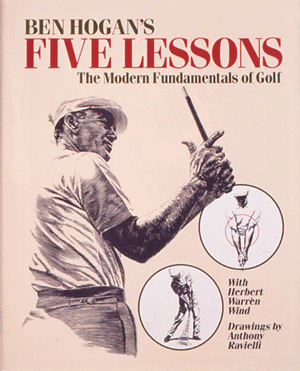The Loop
Saturday Morning Tip: Supinate your wrists like Hogan
The more I study the instructional thoughts from the great players and teachers of the past, the more I realize that the principles they espoused are just as valid today as they were then. For example, take the idea of supination and pronation that Ben Hogan spoke about so clearly and precisely.

In his book Five Lessons: The Modern Fundamentals of Golf, Hogan said: "There is one position of such signal importance that it warrants closeup study. This is the position of the left wrist and hand at the actual moment of impact. [The publisher printed the following words in all caps, but I'll put them in bold so they are easier to read here./RS]
"__At impact the back of the left hand faces toward your target. The wrist bone is definitely raised. It points to the target and, at the moment the ball is contacted, it is out in front, nearer to the target than any part of the hand. __
"When the left wrist is in this position, the left hand will not check or interrupt the speed with which your clubhead is traveling. There's no danger either that the right hand will overpower the left and twist the club over. It can't. As far as applying power goes, I wish that I had three right hands!
"Every good golfer has his left wrist in this supinating position at impact. Every poor golfer does the exact reverse. As his club comes into the ball, he starts to pronate the left wrist--to turn it so that the palm will be facing down."
In other words, Hogan did not want your arms and wrists pronating on the downswing. (Pronate only on the backswing.) He wanted your arms and wrists to turn counterclockwise (to your left as you're looking at the ball) into and through impact, but in a way that your left wrist was slightly bowed and your right wrist bent backward at the moment of truth. This is the classic impact position you see in the small circular image on the cover of the Five Lessons book shown above, as well as on the cover page inside. The result will be a more powerful strike because you are delofting the club through impact while turning the clubface from open to closed, which also creates extra clubhead speed coming into the ball.
It's why really good players--and all tour pros--make that classic ball-then-turf contact resulting in a more penetrating ball-flight. Less-skilled golfers often turn their arms and wrists in the opposite direction--clockwise (to your right as you're looking at the ball) through impact, which cups the left wrist and adds loft to the club. This results in a weak slice and a softer ball flight. As Hogan said, "At the very point in the swing in which [the golfer] should be increasing the speed of his hands, by pronating he slows them down."
So if you want to improve your ball flight and hit your shots farther with more consistency, take a tip from Ben Hogan and supinate your arms and wrists through impact. You might want to combine this move with some gym work with light weights to be sure your arms and wrists are strong so you don't injure yourself. Click here for a Fitness Friday how-to video.
And for more classic images of Ben Hogan swinging the club, click here.
Enjoy your game this weekend, and be sure to follow me on Twitter @RogerSchiffman
*Roger Schiffman
Managing Editor
Golf Digest*